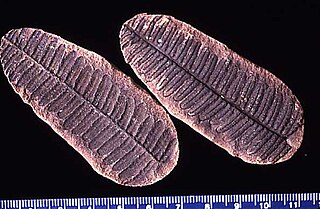
Mariana Pimentel is a municipality in the state of Rio Grande do Sul, Brazil. It is located approximately 75 km from the state's capital, Porto Alegre.
Gangamopteris is a genus of Carboniferous-Permian plants, very similar to Glossopteris. Previously, it was classified as fern with reproduction by seed. The genus is usually only applied to leaves, making it a form taxon. Gangamopteris dominates some coal deposits, such as those of the Beacon Supergroup.

Pecopteris is a very common form genus of leaves. Most Pecopteris leaves and fronds are associated with the marattialean tree fern Psaronius. However, Pecopteris-type foliage also is borne on several filicalean ferns, and at least one seed fern. Pecopteris first appeared in the Devonian period, but flourished in the Carboniferous, especially the Pennsylvanian. Plants bearing these leaves became extinct in the Permian period, due to swamps disappearing and temperatures on Earth dropping.

Sphenopteris is a genus of seed ferns containing the foliage of various extinct plants, ranging from the Devonian to Late Cretaceous. One species, S. höninghausi, was transferred to the genus Crossotheca in 1911.
Samaropsis is a form genus named by Goeppert in 1864. Later Sewart (1917) redefined the taxon to refer only to the seeds.
Cordaicarpus is a form genus named by Geinitz (1862) and redefined by Seward (1917) to avoid confusion with another genus and to establish that the genus refers only seeds. Seward defined the differences between Cordaicarpus and Samaropsis.
Botrychiopsis is an extinct genus that existed from the Carboniferous to the Permian. Vascularized seedless plants (ferns) and reproduction by spores. They leaf type fronds. They lived in locals humid and swampy.
Cheirophyllum is an extinct plant genus that existed during the Permian.

Osmundites is an extinct genus of the familia Osmundaceae. Vascularized seedless plants (ferns) and reproduction by spores. They leaf type fronds. They lived in locals humid and swampy.
Chiropteris is an extinct genus of plants that existed from the Early Permian to the Late Jurassic.
Stephanophyllites is an extinct genus of plants that lived in the Permian.
Kawizophyllum is an extinct genus of plants that lived in the Permian.
Cyclodendron was a genus of lycophytes dating from the Permian. Plants were vascularized with reproduction by spores.
Neomariopteris is a genus of plants dating from the Permian and Triassic Lower. Vascularized seedless plants (ferns) and reproduction by spores. They leaf type fronds. They lived in locals humid and swampy.
Buriadia is a genus that existed from the Carboniferous to the Permian. Vascular plants that are reproduced by seed and the type species had only Buriadia heterophylla. Put the name of Buriadiaceae family.
Portalites is an extinct genus of acritarchs. The species Portalites gondwanensis was located in outcrop Morro do Papaléo in the town of Mariana Pimentel in Brazil, the geopark Paleorrota. The outcrop is in the Rio Bonito Formation and date from Sakmarian in the Permian.
Brazilea is an extinct genus of algae. The species Brazilea helby and Brazilea scissa were located in outcrop Morro do Papaléo in the town of Mariana Pimentel, the geopark Paleorrota. The outcrop dates to the Sakmarian of the Permian.
Leiosphaeridia is an extinct genus of algae or acritarchs. The genus of undefined species were found in outcrop Morro do Papaléo in the town of Mariana Pimentel in Brazil, the geopark Paleorrota. The outcrop date Sakmarian in Permian.
Tetraporina is an extinct genus of algae. The genus of undefined species were found in outcrop Morro do Papaléo in the town of Mariana Pimentel in Brazil, the geopark Paleorrota, on Rio Bonito Formation. The outcrop date Sakmarian in Permian.
Quadrisporites is an extinct genus of acritarchs. The species Q. horridus was located in outcrop Morro do Papaléo in the town of Mariana Pimentel in Brazil, the geopark Paleorrota. The outcrop is in the Rio Bonito Formation and date of Sakmarian in the Permian.



